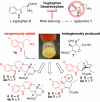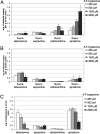Silencing of tryptamine biosynthesis for production of nonnatural alkaloids in plant culture
- PMID: 19666570
- PMCID: PMC2728952
- DOI: 10.1073/pnas.0903393106
Silencing of tryptamine biosynthesis for production of nonnatural alkaloids in plant culture
Abstract
Natural products have long served as both a source and inspiration for pharmaceuticals. Modifying the structure of a natural product often improves the biological activity of the compound. Metabolic engineering strategies to ferment "unnatural" products have been enormously successful in microbial organisms. However, despite the importance of plant derived natural products, metabolic engineering strategies to yield unnatural products from complex, lengthy plant pathways have not been widely explored. Here, we show that RNA mediated suppression of tryptamine biosynthesis in Catharanthus roseus hairy root culture eliminates all production of monoterpene indole alkaloids, a class of natural products derived from two starting substrates, tryptamine and secologanin. To exploit this chemically silent background, we introduced an unnatural tryptamine analog to the production media and demonstrated that the silenced plant culture could produce a variety of novel products derived from this unnatural starting substrate. The novel alkaloids were not contaminated by the presence of the natural alkaloids normally present in C. roseus. Suppression of tryptamine biosynthesis therefore did not appear to adversely affect expression of downstream biosynthetic enzymes. Targeted suppression of substrate biosynthesis therefore appears to be a viable strategy for programming a plant alkaloid pathway to more effectively produce desirable unnatural products. Moreover, although tryptamine is widely found among plants, this silenced line demonstrates that tryptamine does not play an essential role in growth or development in C. roseus root culture. Silencing the biosynthesis of an early starting substrate enhances our ability to harness the rich diversity of plant based natural products.
Conflict of interest statement
The authors declare no conflict of interest.
Figures






Similar articles
-
Aza-tryptamine substrates in monoterpene indole alkaloid biosynthesis.Chem Biol. 2009 Dec 24;16(12):1225-9. doi: 10.1016/j.chembiol.2009.11.016. Chem Biol. 2009. PMID: 20064432 Free PMC article.
-
Directed biosynthesis of alkaloid analogs in the medicinal plant Catharanthus roseus.J Am Chem Soc. 2006 Nov 8;128(44):14276-7. doi: 10.1021/ja066787w. J Am Chem Soc. 2006. PMID: 17076499
-
Assessing the limitations to terpenoid indole alkaloid biosynthesis in Catharanthus roseus hairy root cultures through gene expression profiling and precursor feeding.Biotechnol Prog. 2009 Sep-Oct;25(5):1289-96. doi: 10.1002/btpr.204. Biotechnol Prog. 2009. PMID: 19722248
-
Perspectives of the metabolic engineering of terpenoid indole alkaloids in Catharanthus roseus hairy roots.Adv Biochem Eng Biotechnol. 2013;134:23-54. doi: 10.1007/10_2013_182. Adv Biochem Eng Biotechnol. 2013. PMID: 23576053 Review.
-
[Advance in biosynthesis of terpenoid indole alkaloids and its regulation in Catharanthus roseus].Zhongguo Zhong Yao Za Zhi. 2016 Nov;41(22):4129-4137. doi: 10.4268/cjcmm20162208. Zhongguo Zhong Yao Za Zhi. 2016. PMID: 28933078 Review. Chinese.
Cited by
-
Biosynthesis of Fluorinated Peptaibols Using a Site-Directed Building Block Incorporation Approach.J Nat Prod. 2017 Jun 23;80(6):1883-1892. doi: 10.1021/acs.jnatprod.7b00189. Epub 2017 Jun 8. J Nat Prod. 2017. PMID: 28594169 Free PMC article.
-
A virus-induced gene silencing approach to understanding alkaloid metabolism in Catharanthus roseus.Phytochemistry. 2011 Nov;72(16):1969-77. doi: 10.1016/j.phytochem.2011.07.001. Epub 2011 Jul 27. Phytochemistry. 2011. PMID: 21802100 Free PMC article.
-
The transcription factor CrWRKY1 positively regulates the terpenoid indole alkaloid biosynthesis in Catharanthus roseus.Plant Physiol. 2011 Dec;157(4):2081-93. doi: 10.1104/pp.111.181834. Epub 2011 Oct 11. Plant Physiol. 2011. PMID: 21988879 Free PMC article.
-
RNAi and Homologous Over-Expression Based Functional Approaches Reveal Triterpenoid Synthase Gene-Cycloartenol Synthase Is Involved in Downstream Withanolide Biosynthesis in Withania somnifera.PLoS One. 2016 Feb 26;11(2):e0149691. doi: 10.1371/journal.pone.0149691. eCollection 2016. PLoS One. 2016. PMID: 26919744 Free PMC article.
-
Unnatural spirocyclic oxindole alkaloids biosynthesis in Uncaria guianensis.Sci Rep. 2019 Aug 5;9(1):11349. doi: 10.1038/s41598-019-47706-3. Sci Rep. 2019. PMID: 31383908 Free PMC article.
References
-
- Khosla C, Keasling JD. Metabolic engineering for drug discovery and development. Nat Rev Drug Disc. 2003;2:1019–1025. - PubMed
-
- Birch AJ. The biosynthesis of antibiotics. Pure Appl Chem. 1963;7:527–537.
-
- Weissman K. Mutasynthesis—uniting chemistry and genetics for drug discovery. Trends Biotechnol. 2007;25:139–142. - PubMed
-
- Weist S, Sussmuth RD. Mutational biosynthesis—a tool for the generation of structural diversity in the biosynthesis of antibiotics. Appl Microbiol Biotechnol. 2005;68:141–150. - PubMed
Publication types
MeSH terms
Substances
Grants and funding
LinkOut - more resources
Full Text Sources
Other Literature Sources

